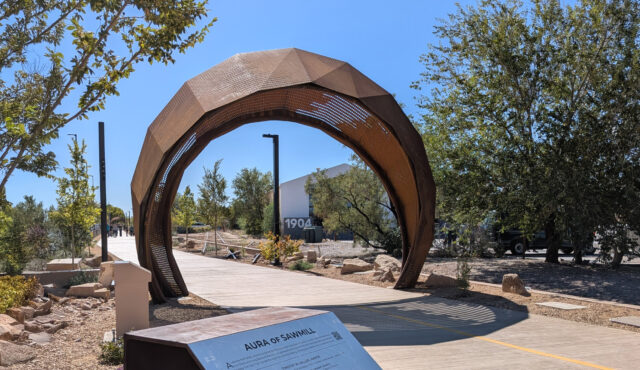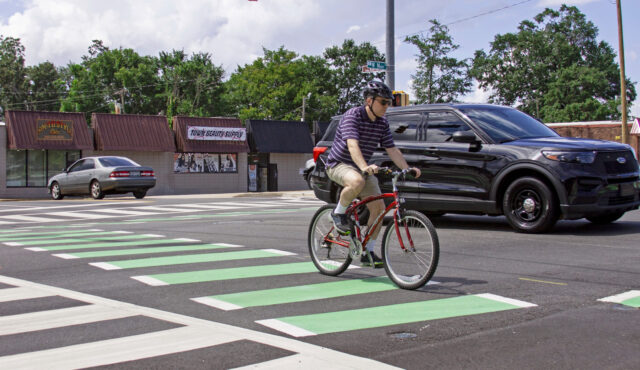Toole Design Group is celebrating World Landscape Architecture Month in April! We’re highlighting the many ways that landscape architects and designers influence our active transportation projects at every stage of the development at our multidisciplinary firm.
At TDG, our landscape architecture practice is integrated into every project, from concept to construction. Landscape architects and urban designers come to the table with our planners and engineers to cross disciplines and create the best possible result on every project.
This spirit of collaboration is no accident – landscape architects prioritize the user experience, from the drawing board to final construction documents. You don’t have to go any further than TDG President Jennifer Toole, AICP, ASLA to discover why this is so deeply embedded into our company values. With a degree in landscape architecture and over 20 years of experience in active transportation planning and design, Jennifer knows the value that a multidisciplinary approach can provide.
For #WLAM2017, she shared how she got her start, what landscape architecture brings to active transportation projects, and how her background in design influenced how TDG worked to become a nationally-recognized firm.
Your background is in landscape architecture. What drew you to the field?
JT: It was not a eureka moment, to be honest. As a high school student, my parents enrolled me in a career counseling service, where you take various personality tests and then get some recommendations. Among the results I received was “landscape architect.” I had no idea what that was, but I did some research, and became more interested.
What stood out to me about the field, and the reason I chose to pursue a career in landscape architecture, was the combination of creativity and practical application. Landscape architects build things – we get to see an idea through from concept to reality. I also love being a consultant and helping our clients achieve great things. There is an ethos to customer service that motivates me every day.
How did that take you into active transportation?
JT: Through my education and early professional years, I learned more about how broad the field is. I started working at a firm that designed greenways, which introduced me to the transportation element of landscape architecture. I found that I loved making spaces that worked from a practical standpoint, but are also beautiful and bring joy to people who use them.
This was about the time Congress passed the Intermodal Surface Transportation Efficiency Act (ISTEA) which provided a major infusion of funding for pedestrian and bicycle facilities. It was the early stages of a whole new field of transportation. I was lucky to be there at the beginning – it’s easier to become known as an expert when there’s only a handful of other people in your field.
How did your experience influence how you started and built a business?
JT: My roots in landscape architecture strongly influenced our formation as a company. It’s always been important to me to actually build things – to go beyond conceptual design and grapple with the challenges of final design. So, we are a soup to nuts company. We go all the way from working on federal transportation policy to designing the slopes of a curb ramp, and can take care of everything in between.
There is no “silo” thinking at Toole Design Group. A lot of firms give lip service to being multi-disciplinary; we work across practice areas every day. Landscape architects & designers are at the table from the start, sometimes leading the project, sometimes as members of the team. They aren’t brought in to “dress it up” after the engineers are done.
In your career, what stands out to you as an example of an active transportation project with great landscape architecture?
JT: A recent example we had the privilege of working on is the reconstruction of Jackson Street in downtown Saint Paul, Minnesota, as a part of the Capital City Bikeway. It was a transformative project – our team was able to completely rethink the street and design it for everyone. It shows the influence of landscape architecture on our projects from concept to construction.
It is also a perfect example of something that is a common thread in a lot of our projects. The Capital City Bikeway is Saint Paul’s first separated bike lane. Being first is never easy. Everyone involved – from the adjacent business owners to the city engineers to the construction crew had to learn a lot of new things. We love helping communities through this process – educating them about the options and helping them make good decisions. It’s the reason a collaborative team of planners, landscape architects and engineers can get the job done better. The end result is not only functional, it’s beautiful. I have to give credit to the City of Saint Paul for their amazing vision on this project – we were so fortunate to get the chance to work on it.


